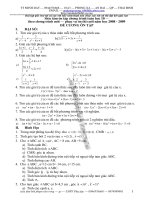Bài đọc 11.2. How Land Reform Shaped Asia’s Tiger Economies (Chỉ có bản tiếng Anh)
Bạn đang xem bản rút gọn của tài liệu. Xem và tải ngay bản đầy đủ của tài liệu tại đây (7.49 MB, 5 trang )
<span class='text_page_counter'>(1)</span><div class='page_container' data-page=1>
<i>News & Events (/news-events) / How Land Reform Shaped Asia’s Tiger Economies</i>
(/)
<b>How Land Reform Shaped Asia’s Tiger</b>
<b>Economies</b>
Asia (/voc/regions/asia) Myanmar (/regions/myanmar) Taiwan (/voc/regions/taiwan) Vietnam (/voc/regions/vietnam)
Land & Food Security (/voc/themes/land-food-security)
agricultural and rural legislation (/voc/landvoc/concept/agricultural-and-rural-legislation)
agricultural land management (/voc/landvoc/concept/agricultural-land-management) agriculture (/voc/landvoc/concept/agriculture)
land investments (/voc/landvoc/concept/land-investments) land reform (/voc/landvoc/concept/land-reform)
land rights (/voc/landvoc/concept/land-rights) mining (/voc/landvoc/concept/mining)
negotiated land reform (/voc/landvoc/concept/negotiated-land-reform)
By Roy Prosterman
Asia’s Tigers, the collection of booming economies that emerged in the East following World War
II, are often hailed as economic miracles. There was, though, no “secret sauce” behind that
</div>
<span class='text_page_counter'>(2)</span><div class='page_container' data-page=2>
Secure land rights for rural people was one of the best-kept secrets in international development
for a time, and now that issue is at the forefront of a revolution
( Governments, funders, corporations, and civil society
are increasingly recognizing the importance of land ownership, or equivalent long-term tenure
rights, to lift people out of extreme poverty
( />
What’s good for rural women and men ( />
the economic development of entire countries
( As economist Joe Studwell observes in How Asia Works, his astute analysis of</i>
the economies of East and Southeast Asia, pro-poor land reforms were critical to giving rise to
Asia’s Tiger economies.
The recipe is relatively simple, as explained in a new infographic by Landesa
( />
1. Favor small family farms, especially by strengthening land rights, to grow employment and
agricultural output.
2. Use the proceeds from the resulting agricultural surpluses to jump-start manufacturing for
export.
3. Encourage the nancial sector to channel capital to family farming and export-focused
manufacturing.
This cycle of economic development begins with land reform, assuring a countryside of small
owner-operators rather than agricultural laborers, squatters, and insecure tenant farmers.
The results speak for themselves. In the decade following Japan’s post-World War II land reform
in 1946, agricultural production increased 50 percent. Over two decades, manufacturing and
mining output increased more than tenfold.
South Korea’s land reform saw rice yields per acre nearly double, while exports climbed an
average of 40 percent per year in the 1960s and 25 percent per year in the 1970s.
In Taiwan, rice yields increased by 60 percent per hectare in the decade following land reform,
while the value of exports grew from 9 percent of GDP in 1952 to 50 percent by 1979.
Stronger land rights enabled farmers to invest in crop diversi cation, which had a dramatic
increase in household incomes. In Taiwan, farm incomes grew by 150 percent in the 10 years
after land reform.
My own experience in Vietnam ( me of the
transformative power of land rights to lift people out of extreme poverty. South Vietnam’s
“land-to-the-tiller” reform of 1970-73 secured land rights for one million farm families, and
led to a 30 percent boost in rice production and 80 percent decline in monthly Vietcong
recruitment ( />id=DJ2FAAAAIAAJ).
The lessons from these reforms are still applicable today
( The government of Myanmar (formerly Burma), emerging from decades of
economic isolation, has prioritized land reform ( one
</div>
<span class='text_page_counter'>(3)</span><div class='page_container' data-page=3>
lacking secure rights to land — the largest subgroup being completely landless agricultural
laborers — pro-poor and market-friendly land reform has the potential to lift 3 million families
out of extreme poverty and jump-start Myanmar’s entire economy.
</div>
<span class='text_page_counter'>(4)</span><div class='page_container' data-page=4>
<i><b>Share this page</b></i>
(/#facebook) (/#email) (/#twitter) (/#linkedin)
( (
(
</div>
<span class='text_page_counter'>(5)</span><div class='page_container' data-page=5>
<b>About us</b>
Who we are (/about)
What we do (/whatwedo)
Privacy policy (/about/privacy-policy)
Terms of use (/about/terms-and-conditions-use)
Contact us (/about/contact-us)
<b>Get involved (/get-involved) </b>
<b>Our mission</b>
The Land Portal Foundation believes access to information is crucial to achieve good land governance and to secure land
rights for vulnerable people. We help partners to create and disseminate land governance data and information through
linked and open data technologies.
Subscribe (/get-involved) Support us (/donate)
Creative Commons Attribution ( 2014-2019 Land Portal Foundation / RSIN
854330045
</div>
<!--links-->
<a href=' women and men ( /><a href=' ( /><a href=' ( /><a href=' ( /><a href=' ( />









